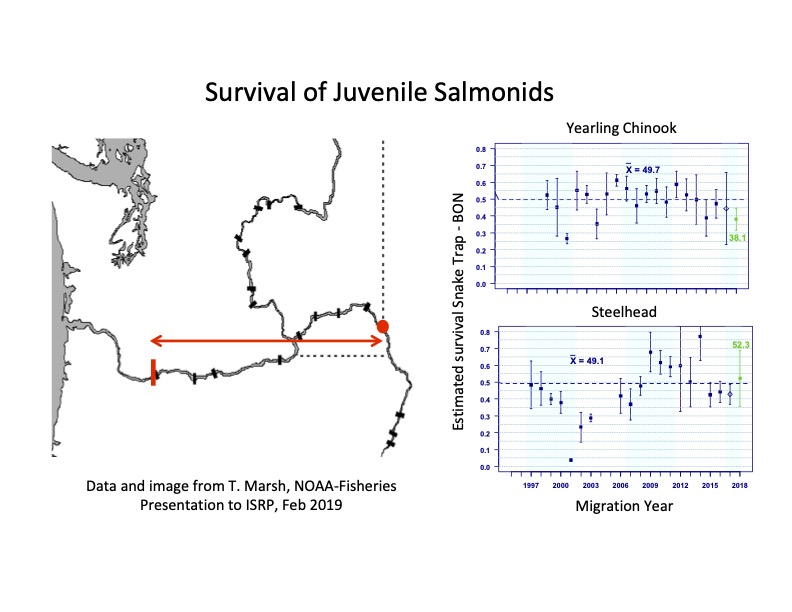forum
library
tutorial
contact

Columbia Basin Badger Club Offers
Both Sides in Debate Over Breaching WA's Snake Dams
by Kirk Williamson
Tri-City Herald, June 14, 2022
|
the film forum library tutorial contact |

|
Columbia Basin Badger Club Offers
by Kirk Williamson
|
 Is it finally time to agree that the four lower Snake River dams should be breached to save salmon runs?
Is it finally time to agree that the four lower Snake River dams should be breached to save salmon runs?
Perhaps no other environmental issue has been more debated in the Northwest than this one. Politicians are increasingly weighing in on the side of breaching -- even while power, farming and shipping interests warn of dire consequences.
The nonprofit Columbia Basin Badger Club first addressed this issue in 2009, and on Thursday, June 16, we will return to the issue from a different viewpoint -- that of veteran Northwest journalists who have covered both sides. The hour-long forum will begin at noon and be presented online through Zoom.
Rocky Barker, retired environmental reporter for the Idaho Statesman in Boise, points out that Northwesterners have spent some $18 billion to mitigate dam impacts on salmon after repeated rulings by federal judges that the agencies operating the dams are violating the Endangered Species Act.
Yet, Barker says, "It's just not good enough. Spring Chinook, sockeye and steelhead are all trending toward extinction in the Snake River watershed that includes the best remaining pristine habitat left in the lower 48 states."
The Statesman has editorialized that breaching the lower Snake dams in Washington to restore salmon runs and mitigating the impacts on power supply, grain transportation and irrigation would be cheaper and more effective.
Barker says the political tide is turning with recognition that dam breaching also is also an issue of tribal justice. And he says fisheries biologists believe restoring wild salmon access to quality high elevation spawning habitat would reverse the loss of these fish runs.
"Now is the time for all of us to come together and do the hard work of securing our future and ending the salmon wars," he says.
But Ken Robertson, the retired executive editor of the Tri-City Herald, says, "The blunt and inarguable answer to Northwesterners who want to breach the Lower Snake River dams and save the salmon is really quite simple: It won't work."
Why?
Robertson maintains it involves simple percentages. From all available studies, it appears about half the salmon smolt that migrate downstream from the handful of Snake River tributaries not blocked by the various dams wedged into Idaho's Snake River canyon, don't reach the Pacific Ocean to begin that phase of their life cycle.
How many will make it to the ocean without the dams? There's plenty of room for debate, but natural predation, warm river temperatures made worse in low-water years because of the naturally low runoff of late summer and early fall and several other factors will still eliminate a large number of the juvenile fish. Is it half as many as the dams? Twice as many? It doesn't really matter.
And Robertson says that no matter how many more survive the trip to the ocean, the brutal fact is that currently only 1% survive to return. Likely even fewer fish than that will return as the impacts of climate change take their toll.
"Breaching the dams consequently is an attempt to solve the wrong problem. It's ocean conditions that are the real problem," he says.
Robertson points to a 2020 study led by Dr. David Welch found salmon survival along the entire west coast of North America has fallen by 65%. Whether a river has dams, no dams, is in the wilds of Northern British Columbia or in Northern California, the statistics are remarkably the same.
"There are plenty of other reasons not to take out the dams, which no doubt will get discussed at the Badger Club forum on June 16. But these numbers are the clincher for me," Robertson said. Registration for the one-hour online forum can be done at columbiabasinbadgers.com. Nonmembers are charged $5 while club members can attend free. An informal half hour called Table Talk will follow where audience members can share thoughts.

learn more on topics covered in the film
see the video
read the script
learn the songs
discussion forum
